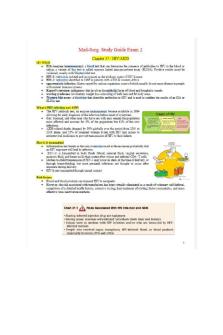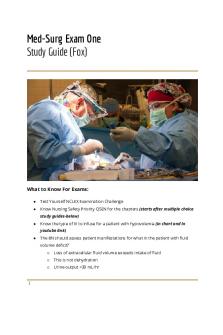Med Surg Chapter 3 Study Guide Health History and Physical Examination PDF

| Title | Med Surg Chapter 3 Study Guide Health History and Physical Examination |
|---|---|
| Course | Medical Surgical |
| Institution | Long Island University |
| Pages | 5 |
| File Size | 59.9 KB |
| File Type | |
| Total Downloads | 10 |
| Total Views | 136 |
Summary
study guide...
Description
Chapter 3 1. Assessment a. hands on data collection process 2. Data collection a. Database- all health info about a pt i. Includes: med hx, physical examination, lab results and diagnostic test and infor contributed by other healthcare providers. 3. Medical Focus a. Information collected is used by nurses and other members of the healthcare team based on the focus of their care. i. Ex. abnormal neurologic examination results by an APN may assist in diagnostic of a stroke 4. Nursing Focus a. Focus of nursing care is the diagnosis and treatment of human responses to actual and potential health problems. b. Nursing history helps determine patients strengths and responses to a health problem i. During nursing history interview and physical examination obtain and record data to support the identification of nursing diagnosis 5. Types of Data a. Subjective data- aka symptoms i. Collected by interviewing patient and/or caregiver ii. Information that can be described or verified only by the patient b. Objective data- aka signs i. Data that can be observed or measured ii. Obtained through 1. Inspection 2. Palpation 3. Percussion 4. Auscultation c. All findings whether subjective or objective are known as clinical manifestations. 6. Interview Considerations a. Purpose of patient interview is to obtain health history information about patients past and present health state b. The nursing history may be complete in one or several sessions depending on the setting and the patient c. You must also make a judgement about the amount of information collected upon initial contact with patient d. In patients with pain and emergency situations, ask only questions pertinent to a specific problem 7. Symptom investigation a. Symptoms experienced by patients are not obsessed b. Remember PQRST
Chapter 3 i. Precipitating ii. Quality iii. Radiation iv. Severity v. timing 8. Culturally competent care: assessment a. During the interview and physical examination be sensitive to issues of eye contact, space, modesty and touching. 9. Important health information a. Past health history i. Ask pt about major childhood and adult illnesses, injuries, and hospitalizations along with surgeries. b. Medications i. Ask pt for specific details related to past and current medication, OTCs, vitamins, herbs and dietary supplements. 1. Important to ask bc it can have an adverse reaction with existing or newly prescribed meds c. Allergies i. Fully explore patients' history of allergies; include detailed description of reaction. d. Surgery and other treatment i. Record all surgeries along with date, reason, and outcome. ii. Ask and record about any blood products received. 10. Functional health patterns a. Health perception health management pattern i. Focuses on perceived level of health and well being ii. Ask what HCP patient uses 1. Ex. a. Native american- medicine man b. Hispanic- curandero iii. Identify risk factors by obtaining a thorough family history, history of personal health habits, and history of exposure to environmental factors. b. Nutritional- metabolic pattern i. Process of ingestion, digestion, absorption and metabolism are assessed ii. Obtain 24 hr diet recall iii. Assess impact of psychological factors iv. Determine if pts present conditions has interfered with eating and appetite 1. Explore symptoms of nausea, intestinal gas, or pain. v. Food allergies are different compared to food intolerances. c. Elimination pattern i. Assess bowel, bladder, and skin function in this pattern ii. Ask frequency and if currently taking laxative and or diuretics. d. Activity exercise pattern
Chapter 3 i.
Assess patients usual pattern of exercise, work activity, leisure, and recreation. e. Sleep- rest pattern i. Patients perception of his or her pattern of sleep, rest, and relaxation in a 24 hour period f. Cognitive-Perceptual Pattern i. Assessing senses and cognitive functions ii. Ask patients how he or she communicates best and if they understand the illness and the treatment plan g. Self perception- self concept pattern i. Included are attitudes about self concept, perception of personal abilities, body image, and general sense of worth. h. Role-relationship pattern i. Reveals patients roles and relationships, including major responsibilities ii. Ask patients to describe family, social, and work roles. i. Sexuality-reproductive pattern i. This pattern describes satisfaction or dissatisfaction with personal secuality and describes reproductive issues. j. Coping- Stress tolerance pattern i. Analyzing the specific stressors or problems that confront the patient, patients perception of stressors, and patients response to stressors. k. Value- Beleif Pattern i. Describes the values, goals, and beliefs ii. Document patients ehtnic background and effects on culture and beliefs on health practices. 11. General survey a. General impression of patient b. Major areas i. Body features ii. Mental state iii. Speech iv. Body movements v. Obvious physical signs vi. Nutritional status vii. Behavior, vital signs, and BMI 12. Physical Examination a. Systematic assessment of patients physical status b. A positive finding indicates that a patient has or has had the particular problem or sign under discussion c. A negative finding is the absence of a sign or symptom usually associated with a problem i. Ex. pt with a liver disease without signs of edema d. Techniques
Chapter 3 i.
Inspection 1. Visual examination of a part or region of the body to assess normal conditions or deciations 2. Compare what is seen with the known 3. Always compare one side of patients body to the other to assess bilaterally for any abnormal findings ii. Palpation 1. Examination of the body using touch 2. Can yield information related to masses, pulsations, organ enlargement, tenderness, swelling, muscular spasms or rigidity, elasticity, vibration of voice sounds, crepitus, moisture, and texture. iii. Percussion 1. Technique that produces sound and vibration to obtain information about the underlying area a. Ex. dullness in RLQ instead of normal tympany iv. Auscultation 1. Listening to sounds produced by body with stethoscope to assess normal conditionals and deviations from normal 2. Bell is sensitive to low pitched sounds (heart murmurs) 3. Diaphragm sensitive to high-pitched sounds (bowel sounds) 4. At conclusion record all findings 13. Emergency Assessment a. Rapid history and examination of a patient while maintaining vital functions 14. Comprehensive Assessment a. Detailed health history and physical examination of all body systems i. Typically performed upon admission to a hospital or a primary care setting 15. Focused Assessment a. Used to evaluate status of previously ifetenidied problems and monitor for signs and symptoms of new problems 16. Using Assessment Approaches a. Focused assessment of the hospitalized patient is frequent and performed by many different people b. During assessment confirm or revise the findings that you read in MR and heard from other HCPs c. When patient arrives to ED with life-threatening condition perform emergency assessment based on elements of primary survey: i. AIRWAY ii. BREATHING iii. CIRCULATION iv. DISABILITY d. Once patient is stabilized focused assessment of respiratory and related body systems can begin
Chapter 3 17. Problem Identification and Nursing Diagnosis a. After completing the history and physical examination, analyze data to develop a list of nursing diagnoses....
Similar Free PDFs

Med Surg 2 Exam 3 Study Guide
- 22 Pages

Med surg exam 3 study guide
- 68 Pages

Med Surg Study guide Notes
- 66 Pages

Med Surg 2 Final Study Guide
- 25 Pages
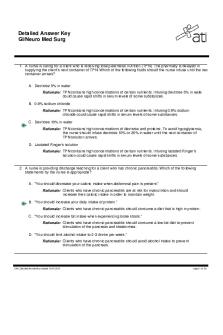
Ati gi med surg - Gi study guide
- 53 Pages
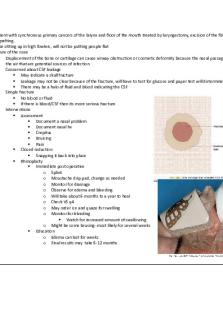
Med Surg II - Exam 2 Study Guide
- 57 Pages

Med surg exam 1 study guide
- 25 Pages
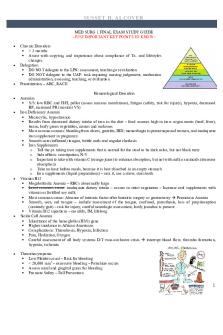
MED SURG 1 Final EXAM Study Guide
- 10 Pages

Med-Surg Test #2 Study Guide
- 10 Pages
Popular Institutions
- Tinajero National High School - Annex
- Politeknik Caltex Riau
- Yokohama City University
- SGT University
- University of Al-Qadisiyah
- Divine Word College of Vigan
- Techniek College Rotterdam
- Universidade de Santiago
- Universiti Teknologi MARA Cawangan Johor Kampus Pasir Gudang
- Poltekkes Kemenkes Yogyakarta
- Baguio City National High School
- Colegio san marcos
- preparatoria uno
- Centro de Bachillerato Tecnológico Industrial y de Servicios No. 107
- Dalian Maritime University
- Quang Trung Secondary School
- Colegio Tecnológico en Informática
- Corporación Regional de Educación Superior
- Grupo CEDVA
- Dar Al Uloom University
- Centro de Estudios Preuniversitarios de la Universidad Nacional de Ingeniería
- 上智大学
- Aakash International School, Nuna Majara
- San Felipe Neri Catholic School
- Kang Chiao International School - New Taipei City
- Misamis Occidental National High School
- Institución Educativa Escuela Normal Juan Ladrilleros
- Kolehiyo ng Pantukan
- Batanes State College
- Instituto Continental
- Sekolah Menengah Kejuruan Kesehatan Kaltara (Tarakan)
- Colegio de La Inmaculada Concepcion - Cebu





